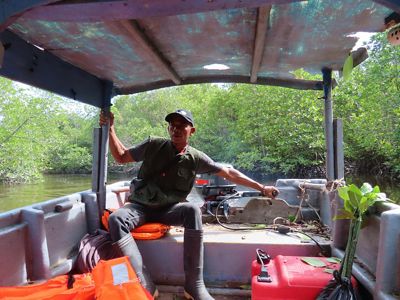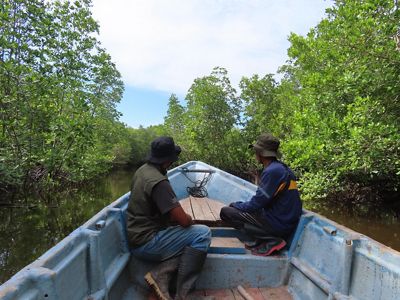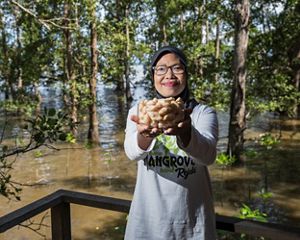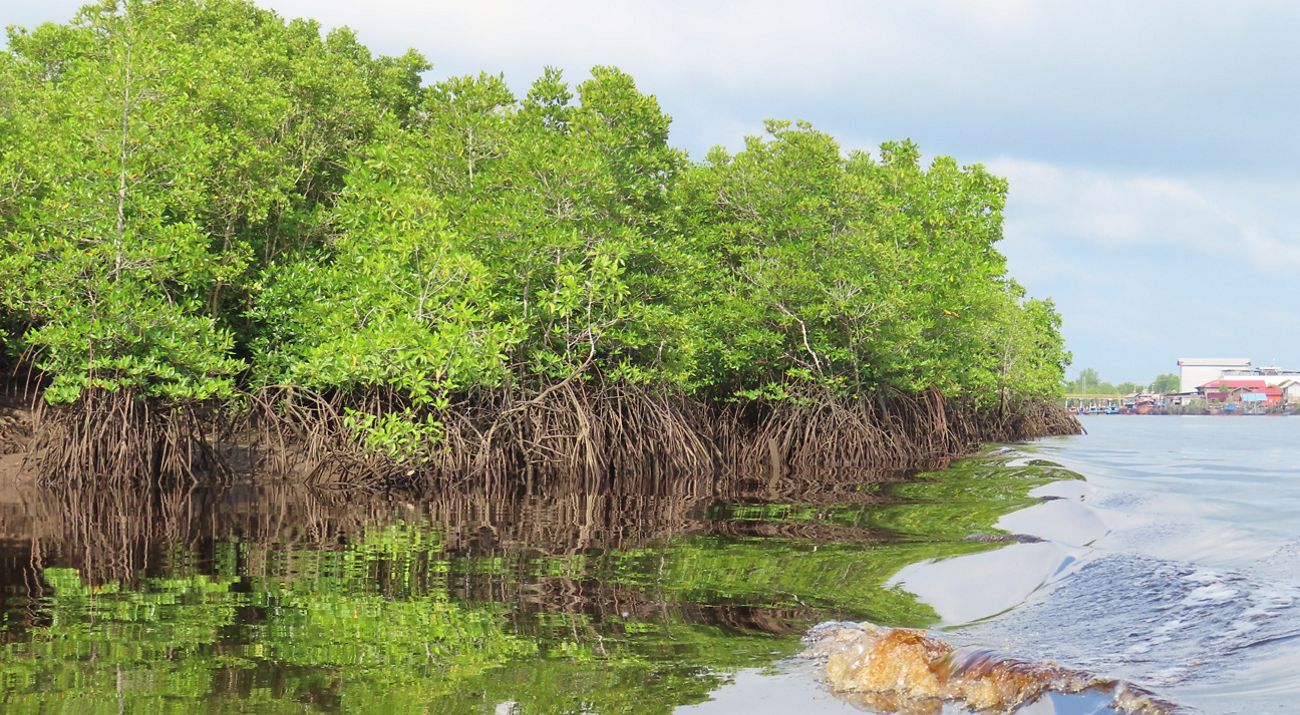
Bengkalis Island, which borders the Malacca Strait, is unique. Covering an area of 911 km2, almost entirely peatland, its coastline is surrounded by mangrove forests. The combination of peat and mangroves on Bengkalis Island yields a high carbon storage capacity, reaching up to 1,969 tons C/ha (YKAN, 2022), surpassing the average mangrove carbon stock in Indonesia, which ranges from 442 to 1,567 tons C/ha.
Read: Prototype Bioprospection Product Inspired by Orangutan Food Plants
However, mangroves on Bengkalis Island have decreased by more than 1,207 ha (equivalent to 1,724 standard FIFA soccer fields) between 1990 and 2019 (YKAN, 2020). The decline in mangrove forests has contributed to erosion on the island with the coastline being the most affected and experiencing a 3-meter annual erosion rate.
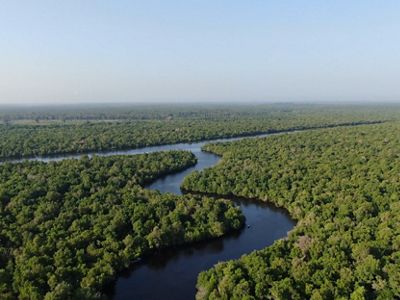
Bengkalis Island is facing significant degradation of its mangrove forest due to intensive fish farming, plantations, and settlements. The primary threat is logging for charcoal production. In the heart of the mangrove forest, spanning 22% of the island’s mangroves, there are 13 charcoal factories (panglong) located on the eastern coast of Bengkalis Island. These factories cater to a wide range of market segments, even extending to Singapore and Malaysia. Each factory processes approximately 3,300 mangrove trees annually, equivalent to the clearing of 2 hectares of forest.
In addition to the local community's dependence on extractive economic sources, the lack of understanding among the community regarding the importance of mangroves and existing regulations has contributed to indifference toward environmental changes. Furthermore, the status of the mangrove forest area on Bengkalis Island is primarily designated as Limited Production Forest (HPT), not a protected forest, making it vulnerable to land-use conversion.
YKAN Mangrove Alliance Program in Riau and Bengkalis
The Indonesian Nature Conservation Foundation (YKAN) initiated an integrated mangrove management program in Riau Province through the Mangrove Ecosystem Restoration Alliance (MERA) platform in 2022. This program aims to establish integrated mangrove management at the provincial level while introducing a Nature-based Solution (NbS)1 approach to mangrove management at the village level.
At the provincial level, the MERA platform played a pivotal role in establishing the Riau Province Mangrove Working Group (KKMD). This group received the Governor of Riau’s approval in June 2022. This multi-stakeholder forum, mandated by the Ministry of Maritime Affairs and Fisheries, is tasked with managing the 226,000 hectares of mangroves in Riau Province. Subsequently, in 2023, YKAN also assisted the Riau KKMD in developing the Riau KKMD Action Plan. This Action Plan will serve as a guideline for the integrated management, protection, and restoration of mangrove ecosystems in Riau, ensuring no overlap in implementation between institutions, from the provincial level down to the village level.
At the village level, YKAN introduced the NbS approach, which focuses on mangrove management and protection, in Teluk Pambang Village, Bengkalis District, as a pilot location. Existing mangrove management and protection should be prioritized over mangrove rehabilitation. Protection mechanisms include various options, from village regulations and social forestry to community participation in the form of patrols and monitoring.
Preventing the loss of existing mangrove forests is more meaningful than having to replant them. A study conducted by YKAN in Bangka Belitung Province in 2024 revealed that rehabilitated mangroves aged 3 to 5 years can only store approximately one-sixth of the total carbon stored in healthy natural mangroves. Kusumangnityas et al. (2021) explain that to achieve maximum carbon storage, mangroves require decades to centuries to grow.
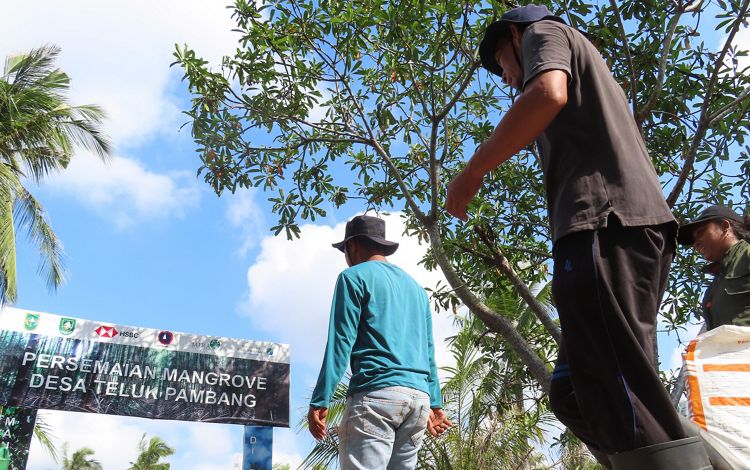
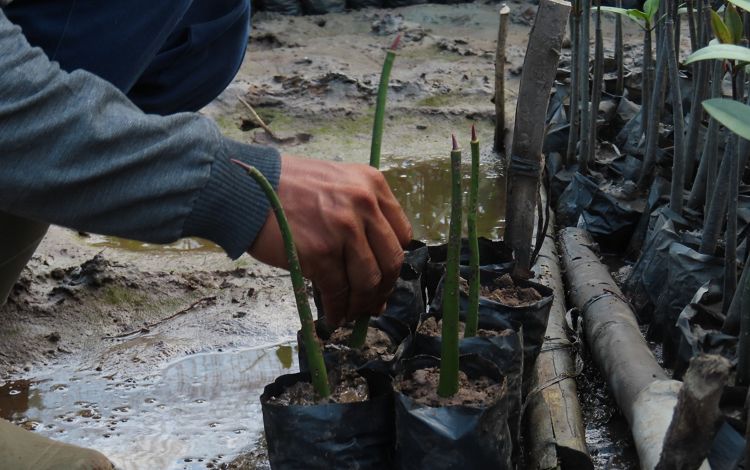
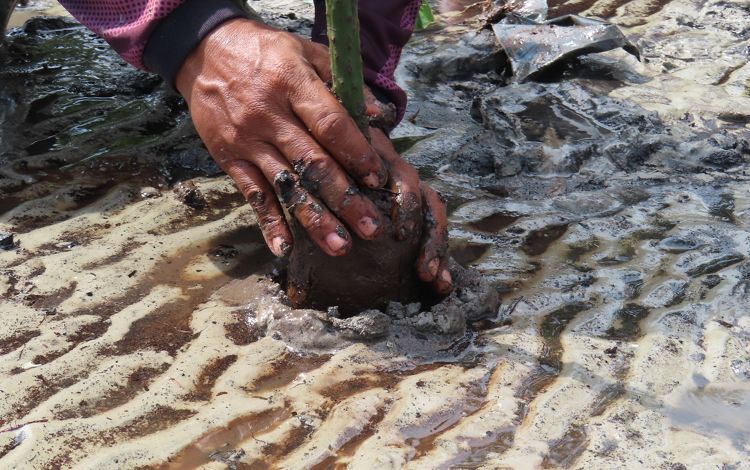
Teluk Pambang Village, spanning 950 hectares of mangrove forests, has regrettably lost 133 hectares of these vital resources between 2016 and 2021 (University of Riau and YKAN, 2025). The primary reasons behind this deforestation are the felling of mangrove trees for charcoal production and the conversion of the land into intensive shrimp ponds. As of 2021, the mangrove forest area in Teluk Pambang Village has been designated as a Limited Production Forest (HPT).
Community participation in protecting mangroves was low at that time since some community groups relied on charcoal production for their livelihoods. To address this, YKAN aimed to enhance community involvement in safeguarding mangrove forests in their villages while simultaneously establishing mechanisms for granting rights to manage and extractive livelihoods from these forests.
YKAN took the initial step of initiating mangrove protection in Teluk Pambang Village. In 2023, they issued a village regulation covering 950 hectares of mangroves. Additionally, YKAN empowered the community to secure legal rights to manage the mangrove area for 35 years through a social forestry scheme approved by the Ministry of Forestry and Environment. This scheme not only protected the mangroves but also provided opportunities for sustainable economic development for the community.
To enhance local community participation while ensuring the sustainability of the mangrove program, YKAN employs a Community-Based Management (CBM) approach. Through this approach, the community is positioned as the subject of conservation, not the object.
Community groups play a vital role in the entire conservation process, from identifying problems to formulating solutions, making decisions, and even leading activities. This process is expected to foster a sense of ownership among community groups so that when the program ends, it is the local community that will continue to manage the mangroves.
In the CBM approach, mangrove restoration is not merely a planting activity, but rather the restoration of the entire ecosystem. CBM strives to establish ideal conditions that allow nature to regenerate naturally, eliminating the need for constant human intervention.
YKAN's mangrove restoration efforts begin with planning based on scientific research, this planning is then used as a guide for the mangrove restoration team in determining the most relevant interventions for each restoration area.
Some examples of interventions include improving hydrology to ensure smooth tidal circulation, which allows mangrove seeds to spread and grow well. Clearing shrubs creates space for fallen mangrove seeds to germinate and grow. Additionally, installing wooden fences on the coastline prone to abrasion traps sediment, creating suitable conditions for mangrove seed growth.
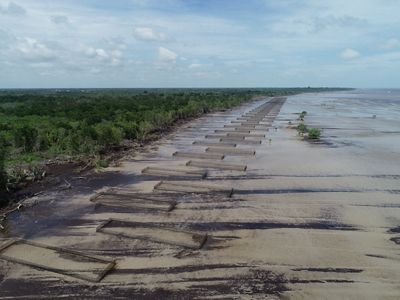
Mangrove seedling planting is only carried out in areas where natural regeneration is not yet possible, such as on beaches vulnerable to large waves. Planting interventions include the use of wooden fences with nets to reduce wave impact. This method can increase seedling survival rates from 0% to over 50%.
Program Results
After three years of activities (2022–2024) in Teluk Pambang Village with support from HSBC Indonesia, YKAN’s NbS approach has demonstrated significant achievements. From 2022 to 2024, the community village government of Teluk Pambang and YKAN achieved a remarkable reduction in the rate of mangrove forest degradation, achieving a staggering 96% decrease. This significant improvement was evident in the reduction of the average annual area of mangrove forest degradation from 27 hectares (2016–2021) to just 1 hectare (2022–2024). This achievement was made possible by two factors. First, the implementation of village regulations on mangrove protection and social forestry covering a mangrove area of 950 hectares.
Second, the CBM approach has encouraged community involvement, leading to a significant increase in mangrove management and protection. Initially, only 5 people participated, but now 170 do, accompanied by a heightened understanding of the significance of mangrove conservation.
This mangrove group has also been equipped with technical skills, including restoration, protection, monitoring, and the use of tools such as the Avenza map app and internet-based mangrove monitoring. The group has also been trained in non-technical skills, including organizational management, administration, program reporting, and proposal development.
Social forestry also provides opportunities and rights for village groups to obtain livelihoods through Social Forestry Business Groups (KUPS), along with the obligations and responsibilities to protect the area. Currently, there are two KUPS in Teluk Pambang Village that obtain alternative livelihoods from mangrove forests, namely the honey bee KUPS and the mangrove biota KUPS (whose products include mangrove fruits, clams, snails, crabs, sepetang, and sekunci).
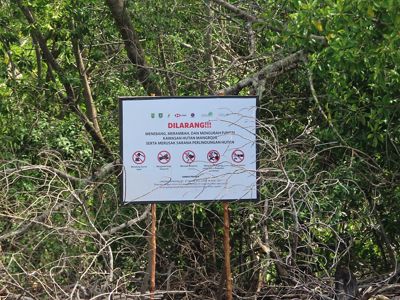
Mangrove ecosystem restoration in Teluk Pambang is also beginning to yield results. The environmental restoration approach has successfully demonstrated improved environmental quality, as evidenced by the emergence of natural mangrove seed regeneration across the 120-hectare monitoring plot. The restoration efforts have resulted in an estimated mangrove tree cover that will be detectable by satellite within the next 3 to 5 years.
Based on the three-year journey of the YKAN mangrove program in Pambang Bay, these achievements demonstrate that the NbS approach is highly relevant for reducing the rate of mangrove degradation and improving environmental quality.


